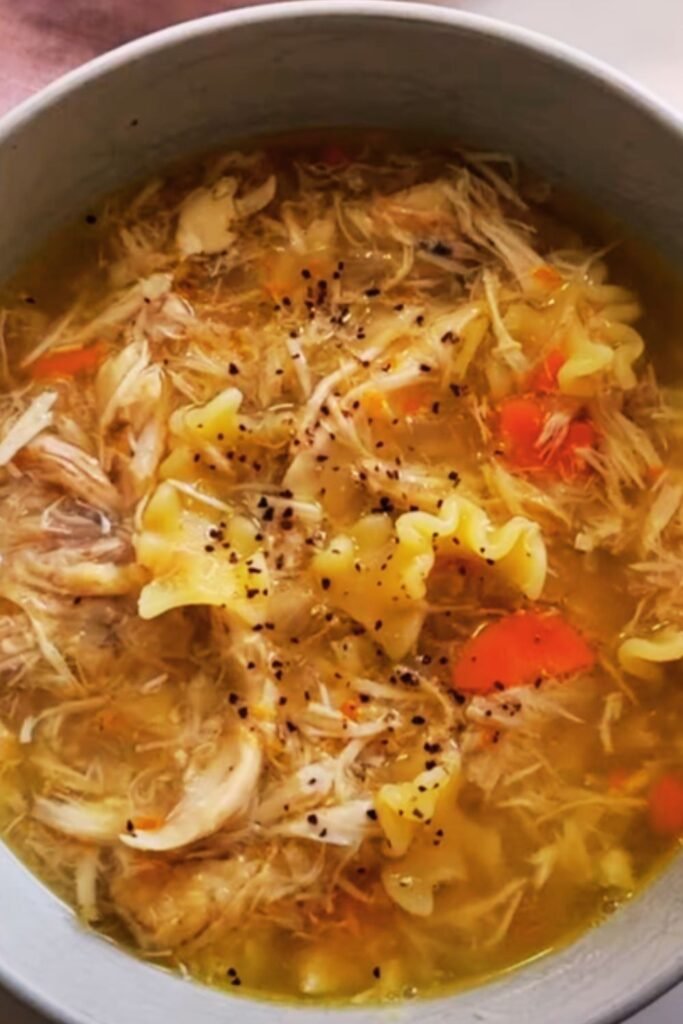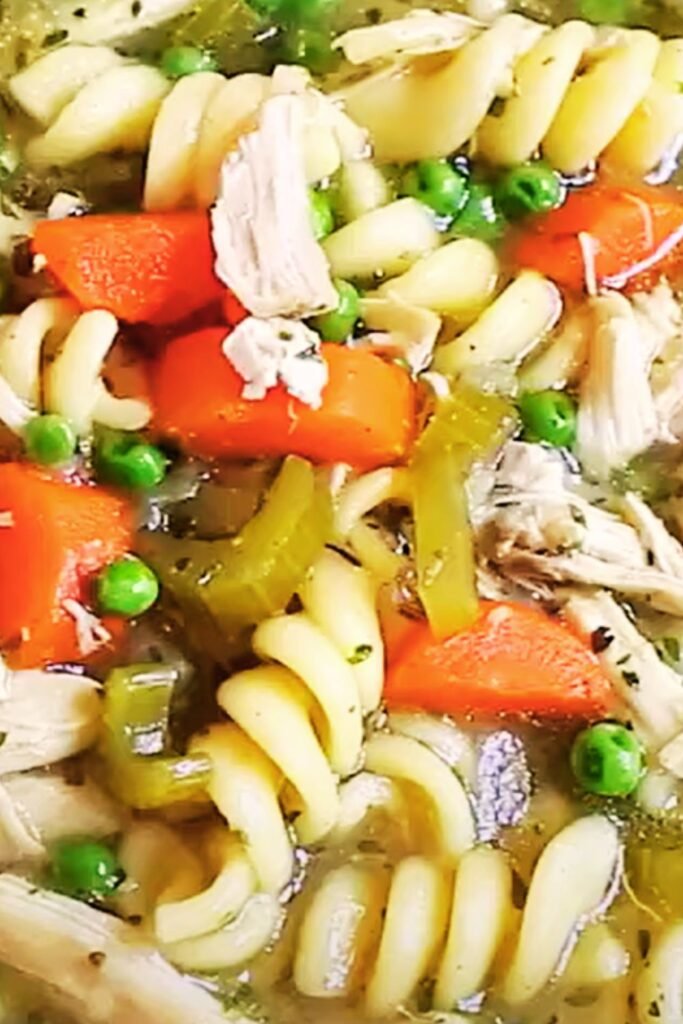There’s something magical about the aroma of chicken soup simmering away, filling your home with warmth and comfort. I’ve been perfecting my Instant Pot chicken and vegetable soup recipe for years, and I can honestly say it’s become my family’s most requested meal during chilly weather. What used to take me hours on the stovetop now comes together beautifully in under an hour, thanks to the pressure cooking magic of my trusty Instant Pot.
The beauty of this recipe lies not just in its convenience, but in how the pressure cooking process intensifies flavors while keeping the chicken incredibly tender and the vegetables perfectly cooked. I’ve served this soup to skeptical friends who swore nothing could beat their grandmother’s slow-simmered version, only to watch them ask for seconds and the recipe by the end of the evening.
Why I Choose the Instant Pot for Chicken Soup
When I first got my Instant Pot, I was honestly skeptical about making soup in it. How could something that fast possibly develop the deep, rich flavors I associated with good chicken soup? After my first attempt, I was completely converted. The pressurized environment creates an incredibly efficient cooking method that extracts maximum flavor from every ingredient while preserving nutrients that might otherwise be lost through traditional cooking methods.
The controlled pressure environment also means I can use less expensive cuts of chicken and still achieve fork-tender results. I often use chicken thighs for their superior flavor and texture, but even chicken breasts come out perfectly moist when cooked under pressure with the right timing.
Essential Ingredients for Perfect Chicken Vegetable Soup
Let me walk you through the ingredients that make this soup extraordinary. I’ve tested countless variations, and these components create the perfect balance of flavors and textures.
Protein Foundation
Chicken Selection: I prefer using a combination of chicken thighs and breasts. The thighs provide rich flavor and stay incredibly moist, while the breasts add lean protein. If you’re watching your fat intake, you can use all breasts, but I recommend not overcooking them.
Bone-in vs. Boneless: While boneless chicken is more convenient, I sometimes use bone-in pieces for the first part of cooking, then remove the bones before adding vegetables. The bones add incredible depth to the broth.
Vegetable Medley
My vegetable selection has evolved over time, and I’ve found this combination provides the best texture and flavor balance:
- Carrots: I cut these into slightly larger pieces since they hold their shape well under pressure
- Celery: Essential for that classic soup flavor – I include both stalks and leaves
- Onions: Yellow onions provide the best flavor base, though I sometimes add a bit of sweet onion for complexity
- Potatoes: Yukon Gold potatoes are my preference – they’re creamy without falling apart
- Green beans: Fresh or frozen work equally well
- Corn: Adds natural sweetness and beautiful color
- Peas: I add these at the very end to maintain their bright color and texture

Flavor Enhancers
The secret to my soup’s incredible taste lies in these carefully chosen seasonings and aromatics:
Fresh Herbs: I use a combination of fresh thyme, rosemary, and parsley. If you only have dried herbs, use about one-third the amount.
Garlic: Fresh garlic is non-negotiable in my kitchen. I typically use 4-5 cloves, minced fine.
Bay Leaves: These add an subtle but essential depth. I always remove them before serving.
My Detailed Instant Pot Chicken Soup Recipe
Ingredients List
| Ingredient | Quantity | Notes |
|---|---|---|
| Chicken thighs (boneless) | 1.5 lbs | Can substitute with breasts |
| Chicken breasts | 1 lb | Cut into chunks |
| Yellow onion | 1 large | Diced |
| Carrots | 3 large | Cut into 1/2-inch pieces |
| Celery stalks | 3 stalks | Chopped with leaves |
| Yukon Gold potatoes | 2 medium | Cubed |
| Green beans | 1 cup | Fresh or frozen |
| Corn kernels | 1 cup | Fresh or frozen |
| Frozen peas | 1/2 cup | Added at end |
| Garlic cloves | 5 cloves | Minced |
| Fresh thyme | 2 tablespoons | Or 2 teaspoons dried |
| Fresh rosemary | 1 tablespoon | Or 1 teaspoon dried |
| Bay leaves | 2 leaves | Remove before serving |
| Chicken broth | 6 cups | Low-sodium preferred |
| Water | 2 cups | Adjust as needed |
| Olive oil | 2 tablespoons | For sautéing |
| Salt | To taste | Start with 1 teaspoon |
| Black pepper | 1/2 teaspoon | Freshly ground |
| Fresh parsley | 1/4 cup | Chopped for garnish |
Step-by-Step Cooking Instructions
Preparation Phase (10 minutes): I always start by prepping all my ingredients before turning on the Instant Pot. This ensures smooth cooking without any rushed moments. Cut your chicken into uniform pieces, dice your vegetables to similar sizes, and have all seasonings measured and ready.
Sautéing Phase (8 minutes): Set your Instant Pot to the sauté function and heat the olive oil. I season the chicken pieces with salt and pepper, then brown them in batches. Don’t overcrowd the pot – proper browning creates those delicious fond bits that will enhance your soup’s flavor. Remove the chicken and set aside.
In the same pot with those beautiful browned bits, add your diced onions. Cook for about 3 minutes until they start to soften, then add the minced garlic and cook for another 30 seconds until fragrant.

Building the Soup Base (5 minutes): Add the chicken broth and water to the pot, scraping up any browned bits from the bottom – this is where incredible flavor lives. Return the browned chicken to the pot, then add your carrots, celery, potatoes, thyme, rosemary, and bay leaves.
Pressure Cooking Phase (25 minutes total): Secure the Instant Pot lid and set the valve to sealing. Select manual/pressure cook on high pressure for 8 minutes. The pot will take about 10-12 minutes to come to pressure, cook for 8 minutes, then I allow for a 5-minute natural pressure release before quick-releasing the remaining pressure.
Final Assembly (5 minutes): Carefully remove the lid and check that your chicken is tender and vegetables are cooked through. Add the green beans and corn, then set the pot to sauté mode again. Simmer for 3-4 minutes until these vegetables are tender-crisp. Stir in the frozen peas during the last minute – they’ll cook perfectly from the residual heat.
Taste and adjust seasoning with salt and pepper. Remove the bay leaves and stir in fresh chopped parsley before serving.
Nutritional Information and Health Benefits
This Instant Pot chicken and vegetable soup is not just delicious – it’s incredibly nutritious. Each serving provides a balanced combination of lean protein, complex carbohydrates, and essential vitamins and minerals.
Nutritional Breakdown (Per Serving – Recipe serves 8)
| Nutrient | Amount | % Daily Value |
|---|---|---|
| Calories | 285 | 14% |
| Protein | 28g | 56% |
| Carbohydrates | 22g | 7% |
| Dietary Fiber | 4g | 16% |
| Total Fat | 8g | 12% |
| Saturated Fat | 2g | 10% |
| Sodium | 680mg | 30% |
| Vitamin A | 184% DV | 184% |
| Vitamin C | 25% DV | 25% |
| Iron | 15% DV | 15% |
| Calcium | 8% DV | 8% |
Health Benefits I’ve Noticed
Since incorporating this soup into my regular meal rotation, I’ve noticed several health benefits. The high protein content helps me feel satisfied for hours, while the variety of vegetables provides essential micronutrients that support immune function – especially important during cold and flu season.
The soup is naturally low in calories but high in volume, making it perfect for weight management. The fiber from the vegetables supports digestive health, and the anti-inflammatory properties of the herbs and garlic provide additional wellness benefits.
Customization Options and Variations
One of the things I love most about this recipe is its incredible versatility. Over the years, I’ve developed numerous variations based on dietary needs, seasonal availability, and personal preferences.
Dietary Modifications
Low-Carb Version: I simply omit the potatoes and corn, adding extra green vegetables like broccoli, cauliflower, or zucchini. The soup remains hearty and satisfying while significantly reducing the carbohydrate content.
Dairy-Free Consideration: This recipe is naturally dairy-free, making it suitable for those with lactose intolerance or following a dairy-free lifestyle.
Gluten-Free Assurance: All ingredients in my base recipe are naturally gluten-free, but always check your broth label to ensure it doesn’t contain any gluten-containing additives.
Seasonal Variations
Spring Version: I add asparagus, fresh spinach, and baby potatoes. The lighter vegetables perfectly complement the season’s fresh flavors.
Summer Adaptation: Fresh tomatoes, zucchini, and yellow squash create a lighter, brighter soup perfect for cooler summer evenings.
Fall Harvest: Sweet potatoes, butternut squash, and kale transform this into a heartier, more warming meal perfect for autumn weather.
Winter Comfort: I add parsnips, turnips, and extra root vegetables for a more substantial, warming version that fights off winter chills.

Storage and Meal Prep Tips
This soup has become a cornerstone of my meal prep routine. It stores beautifully and actually tastes even better the next day as the flavors continue to meld.
Storage Guidelines
Refrigerator Storage: The soup keeps perfectly in the refrigerator for up to 5 days. I store it in glass containers with tight-fitting lids to maintain freshness and prevent flavor transfer.
Freezer Storage: This soup freezes beautifully for up to 3 months. However, I’ve found that potatoes can become slightly grainy after freezing, so for freezer batches, I sometimes omit them or add them fresh when reheating.
Portion Control: I often freeze individual portions in freezer-safe containers or bags. This makes it incredibly convenient to grab a healthy, homemade meal whenever I need one.
Reheating Instructions
From Refrigerated: I reheat gently on the stovetop over medium-low heat, stirring occasionally. This usually takes about 5-7 minutes.
From Frozen: I prefer to thaw overnight in the refrigerator, then reheat as above. If I’m in a hurry, I can reheat directly from frozen, but it takes longer and requires more frequent stirring.
Microwave Option: While not my preferred method, individual portions reheat well in the microwave. I use 50% power and stir every minute to ensure even heating.
Troubleshooting Common Issues
Over the years of making this soup, I’ve encountered and solved various issues that home cooks commonly face.
Texture Problems
Overcooked Vegetables: If your vegetables turn mushy, you’re likely cooking them too long under pressure. Remember that vegetables continue cooking during the natural pressure release, so factor this into your timing.
Dry Chicken: This usually happens when using only chicken breasts or cooking too long. Chicken thighs are more forgiving, but if using breasts, stick to the recommended 8-minute cooking time.
Watery Broth: If your soup lacks body, try sautéing your aromatics longer before pressure cooking, or add a slurry of cornstarch and cold water after cooking to thicken slightly.
Flavor Issues
Bland Soup: This often indicates under-seasoning or insufficient browning of the chicken. Always taste and adjust seasoning at the end, and don’t skip the browning step.
Overly Salty: If you’ve over-salted, add diced potatoes and simmer for 10 minutes – they’ll absorb excess salt. You can also dilute with additional unsalted broth.
Serving Suggestions and Pairings
I’ve served this soup in countless ways, and certain combinations have become family favorites.
Bread Pairings
Fresh crusty bread, homemade biscuits, or cornbread make excellent accompaniments. I particularly love serving it with my sourdough bread – the tangy flavor complements the soup beautifully.
Light Meal Options
For a lighter meal, I serve smaller portions with a fresh green salad dressed with lemon vinaigrette. The acidity of the dressing provides a nice contrast to the rich soup.
Hearty Meal Presentations
When I want to make this soup more substantial, I serve it over cooked rice, quinoa, or egg noodles. This transforms it from a starter into a complete, filling meal.
Garnish Ideas
Fresh herbs, a dollop of Greek yogurt, or a sprinkle of parmesan cheese can elevate the presentation. I sometimes add a drizzle of good olive oil and a crack of fresh black pepper just before serving.
Frequently Asked Questions
Q: Can I use frozen chicken in this recipe? A: Absolutely! I often use frozen chicken when I forget to thaw ahead of time. Just add an extra 2-3 minutes to the pressure cooking time. The chicken will cook perfectly and be just as tender.
Q: What if I don’t have all the vegetables listed? A: This recipe is incredibly forgiving. Use whatever vegetables you have on hand – broccoli, cauliflower, parsnips, or turnips all work wonderfully. The key is cutting them into similar-sized pieces for even cooking.
Q: Can I make this soup ahead for a dinner party? A: Yes! I actually prefer making this soup a day ahead. The flavors develop beautifully overnight, and it’s one less thing to worry about when entertaining. Just reheat gently before serving.
Q: How can I make this soup spicier? A: I sometimes add a pinch of red pepper flakes during the sautéing phase, or stir in some hot sauce at the end. Fresh jalapeños added with the other vegetables also work well for those who enjoy more heat.
Q: Is it normal for the chicken to look a bit gray after pressure cooking? A: Yes, this is completely normal and doesn’t affect the taste or safety. The pressure cooking environment causes this color change, but the chicken will be perfectly cooked and delicious.
Q: Can I double this recipe? A: You can, but be careful not to exceed your Instant Pot’s maximum fill line. I typically don’t go beyond 1.5 times the recipe in my 6-quart Instant Pot to ensure proper pressure building and even cooking.
Q: What’s the best way to shred the chicken if I want a different texture? A: After pressure cooking, I remove the chicken pieces and shred them with two forks while they’re still warm. Then I return the shredded chicken to the pot. This creates a different texture that some people prefer.
Q: Can I add dairy to make it creamier? A: Absolutely! I sometimes stir in a splash of heavy cream or half-and-half at the very end of cooking. Greek yogurt also works well and adds protein while creating a creamy texture.
This Instant Pot chicken and vegetable soup has truly transformed my approach to weeknight cooking. It’s become my go-to recipe when I want something nutritious, comforting, and satisfying without spending hours in the kitchen. The beauty of this recipe lies not just in its convenience, but in how it brings people together around the table, sharing stories over steaming bowls of homemade goodness.
I encourage you to make this recipe your own – adjust the vegetables based on your preferences, experiment with different herbs and seasonings, and don’t be afraid to make substitutions based on what you have available. The most important thing is creating something delicious that your family will love and ask for again and again.